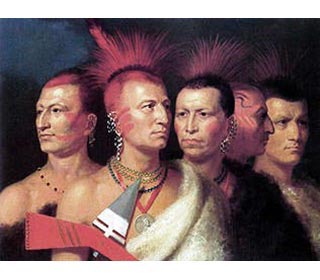Eastern Woodland region is divided into four different areas which have different environments: - The Northeast Woodlands
- The Great Lakes and Woodlands
- The Prairie and Woodlands
- The Southeast Woodlands
Woodland Indians - Lifestyle (Way of Living) - Name of Group: Northeast / Eastern Woodlands Indians
- Culture: Hunter-gatherers, farmers, fishers, trappers
- Languages: Algonquian
- Geography of the State of Eastern Woodlands Indians: Lush woodlands, rivers, ocean
- Animals: Squirrels, white-tailed deer, raccoon, bear, squirrel, beaver, moose, and caribou
- Fish and Sea Mammals: Whales, Seal, Fish and shell fish
- Crops: Corn (maize), pumpkin, squash, beans and tobacco
- Trees: Poplars, birches, elms, maples, oaks, pines, fir trees and spruces and fir trees.
- Transport: Birchbark canoes
- Clothing: Little clothing in the summer, animal skins (Buckskin) in winter
- Types of housing, homes or shelters: Chickees, Wigwams aka Birchbark houses and Longhouses
- Famous Tribes of Eastern Woodlands: Miami, Lenape, Iroquois, Massachusett, Powhatan, Abenaki, Shawnee and Pequot, Fox, Sauk, Wampanoag, Delaware, Huron (Wyandot), Mohawk, Mohican and Menominee
- The Native Indians who lived on the borders of lands often reflected two different types of lifestyles
Woodland Indians - Houses, Shelters and Homes
The different types of Houses, Shelters and Homes depended on the materials available and whether the home was permanent or temporary. The homes of the Eastern Woodlands Indians included Wigwams aka Birchbark houses and Longhouses. Inter-tribal warfare was harsh and frequent so that people of some tribes lived in villages which were fortified by fencing and reinforced with dirt. They tended to live near water. Woodland Indians - Languages
The languages of the Woodland Indians included the Algonquian and Iroquoian languages.
Woodland Indians - Religion, Ceremonies and Beliefs
The Religion, Ceremonies and Beliefs were based on Animism. Animism was a commonly shared doctrine, or belief, of the indigenous people of North America and Canada including the Woodland Indian tribes. Animism is based on the spiritual or religious idea that the universe and all natural objects have souls or spirits. In this religion it is believed that souls or spirits exist not only in humans but also in animals, plants, trees, rocks etc. This belief is also extended to natural phenomena such as thunder storms and rain and geographic features such as mountains, caves or rivers also possess souls or spirits. Face paint or War paint was applied by the Woodland tribes to intimidate their enemies but also to give them protection against evil spirits. There were various ceremonies and festivals relating to the corn crops including the the Green Corn festival. These ceremonies and festivals included feasting and music using rattles and drums. Heroic figures or "transformers" who transform, or change, the world into its present state feature in the legends and myths of the Woodland peoples. Woodland Indians - The Dreamcatcher
This group was believed to have created the Dreamcatcher, which was a protective charm or device. The Dreamcatcher was believed to protect a person from the bad spirits that appeared in dreams. The dreamcatcher was constructed in a spider web design. A wooden hoop was attached to a woven web or loose net, like a spider's web. The dreamcatcher is then decorated with personal and sacred items such as feathers and beads. It was said that "Nightmares pass through the holes and out of the window. The good dreams are trapped in the web, and then slide down the feathers to the sleeping person." Woodland Indians - Wampum
Wampum was extremely important to this culture group. Wampum are the traditional, sacred shell beads of Eastern Woodlands tribes used for currency, recording special events and marking exchanges for engagement, marriage, and betrothal agreements. Woodland Indians - The Cry Ceremony
There were several ceremonies which were important to the Woodland Indians. Notably the Cry Ceremony. When someone in a Woodland tribe died, the tribe would hold a cry ceremony. To prepare for the ceremony five knots were tied in a piece of milkweed. Milkweed was abundant in the longleaf pine forests and were plants with milky sap and light wind-blown seeds. The chief of the tribe performed dances and sang around a fire. The ceremony lasted five days and on each day one of the knots would be untied. Woodland Indians - Physical Characteristics
The physical characteristics of Eastern woodland Indians are dark brown eyes, prominent cheek bones, straight black hair, and scantiness of beard. The skin color of Native Indians varies from very light in some tribes such as the Cheyenne, to almost black in others, such as the Caddo and a yellowish color in such as the Flatheads.
Woodland Indians - Geography and Environment
The Geography and Environment can be generally described as a region of moderate climate with high levels of rainfall. Lakes, including the Great Lakes, rivers and forests. - The Northeast Woodlands - pine trees and Fir trees
- The Great Lakes and Woodlands - birch and beech tree forests and woods
- The Prairie and Woodlands
- The Southeast Woodlands - semi-tropical cypress swamps and pines
Woodland Indians - Animals
The animals were very important to the Northeast Woodland Indians. Squirrels, white-tailed deer, bear, moose, beavers, and raccoons. Fish and Sea Mammals included Whales, Seal, Fish and shell fish of the coast including clams, oysters, lobsters, mussels. The uses of the animals were varied and included food, clothing, shelter and decorations. Dogs were the only domesticated animals. Woodland Indians - Clothing
The clothing of the Woodland Indians were generally made of buckskin, deer skin without hair or fur. The men wore loincloths, leggings, shirts and moccasins. The women wore grass dresses or skirts and moccasins. The picture at the top of the page shows a Fox Warrior which illustrate the typical clothing worn by a Woodland man.
Woodland Indians - Plants, Trees and Crops
The crops included beans, corn, pumpkins, squash and tobacco. The trees included poplars, birches, elms, maples, oaks, pines, fir trees and spruces and fir trees. |
